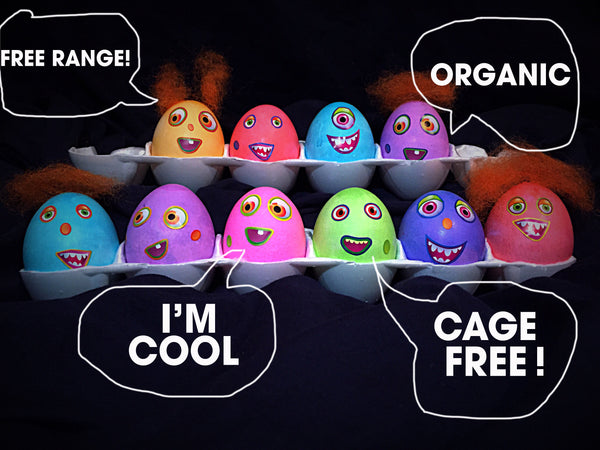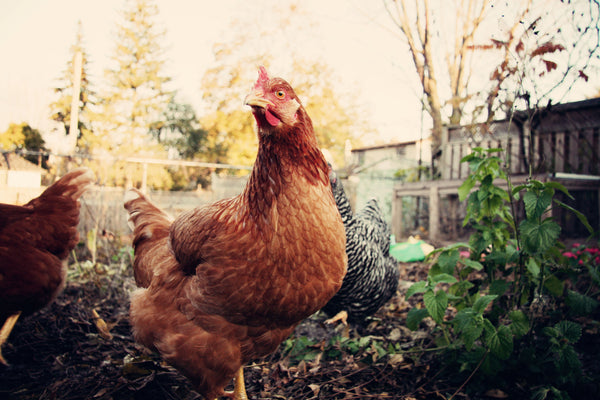- Continue Shopping
- Your Cart is Empty
Eggs: What does free range or organic mean?

Scrambled, fried, poached -- these are terms all egg fans know well. But organic, free range, and cage free? I, for one, am always scratching my head in the dairy section, wondering if the carton with the happy hens on it is really worth five dollars more than the ho-hum styrofoam one mysteriously claiming to be Grade A.
Is it just a marketing gimmick targeting guilty pseudo-vegetarians like me? Is the difference only in the treatment of the hens, or is one egg healthier for me than another? I always go for the luxury eggs just in case, then promptly forget to Google it when I get home.
So the other day, I finally researched these labels, all vaguely evocative of a bucolic farm where animals frolic in the sunlight. I found that, generally speaking, these are the definitions that the industry has settled on:
Organic eggs come from uncaged hens that are free to roam in their houses, have access to the outdoors, and are fed an organic diet of feed produced without conventional pesticides or fertilizers.
Cage-free eggs come from hens that are allowed to roam in a room or open area, typically a barn or poultry house.
Free-range eggs come from hens raised outdoors or with access to the outdoors.
These all sound lovely, right? But here’s the thing: while the USDA does regulate organic, cage-free, and free-range labels, its requirements are minimal and loosely-worded.
This means that producers can pretty much do their own thing, often taking advantage of the ambiguity of definitions and finding loopholes. Buzz phrases like “cage-free” and “outdoor access” don’t exactly mean what we hope they mean.
First, cage-free means that hens aren’t confined to traditional battery cages, which sounds great. These cages are veritable torture chambers for a number of reasons -- for starters, the cages are slanted so that the eggs roll down for easy retrieval, and the hens’ feet get cut from just, like, standing awkwardly on wire.
Can you imagine living your entire life on a slant?! But cage-free literally means that the hens are just dumped on the floor of the poultry house, still as crowded and sick as their slanted friends. So, cage-free ain’t a whole lot prettier than cage city.
The same goes for outdoor access. Somehow, the USDA decided that a single window of whatever size counts as outdoor access…? It’s almost as bad as New York City real estate.
All too often, the closest that free-range hens get to the outdoors is an occasional breeze wafting their own odors back at them. These guys can go their entire lives without ever seeing natural sunlight.
And, for all of these labels, cruel practices like beak-cutting and forced molting are still routine. Oh, and the whole antibiotic-free thing? Yes, there are tremendous issues with preventive antibiotics, but just like we need antibiotics sometimes when we’re sick, animals do, too...and when they don’t get them, they often die slowly from various infections. Farms that uniformly ban antibiotics aren’t as kind as we think they are.
Finally, in terms of health benefits for us, despite all the bloggers who claim that the free-range/cage-free eggs are better for us, science kind of says otherwise. In terms of how our body processes it, an egg is an egg is an egg.

So, what do we make of all this? Is there any reason to splurge on the Cadillac eggs, if their producers aren’t actually practicing what they preach? My conclusion is this: if you care more about dollars than hens, cheap factory eggs are nutritionally indistinguishable from fancy ones.
But if you’re going for humane sourcing, the labels alone aren’t of much use; however, there are actually third party certification programs with higher standards whose approved products are generally more reliable.
The Certified Humane seal, for instance, has specific free-range requirements that far surpass the USDA’s, and they offer tons of suggestions for brands that are doing the animal welfare thing right. After reading some of their publications, I’ll be buying Nellie’s Nest Eggs the next time I require an omelette.

- What's The Deal With Grass Fed Beef? Understanding Labels.
- Episode 37: Roz Savage, Ocean Rower
- Paleo & Osteoporosis
Nik Hawks
Nik Hawks helps run the show at Paleo Treats. Fascinated by humans in all their strange glory, Nik is harnessed in and pulling hard in pursuit of excellence with the rest of the PT Crew. Enjoy!







